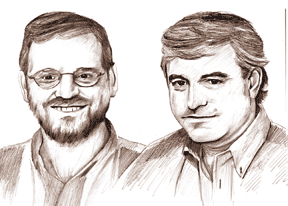INTERVIEW
Recurring Impulses of Definite Pattern
Elliott Wave Experts
by Jayanthai Gopalakrishnan and Dennis Peterson
Fibonacci numbers, fractal geometry, socionomics - Ralph Nelson Elliott's wave theory was published 64 years ago, but he explored ideas that we still study today in physics, behavioral sciences, and, of course, investing. How do the concepts he examined translate to the markets - and the world - today? To find out, STOCKS & COMMODITIES Editor Jayanthi Gopalakrishnan and Staff Writer Dennis Peterson interviewed two experts on Elliott wave analysis, Steven Hochberg and Peter Kendall, in late August 2001.
Steven Hochberg is the co-editor of The Elliott Wave Financial Forecast and Short Term Update, both publications of Robert Prechter's Elliott Wave International (EWI) in Gainesville, GA. Hochberg began his financial career with Merrill Lynch and joined EWI in 1994.
Peter Kendall is the co-editor of The Elliott Wave Financial Forecast. He was a financial reporter and columnist before he joined EWI in 1992.

The wave principle is all about utility. It's an extremely pragmatic tool that is derived directly from the market itself. - Peter Kendall (left), and Steven Hochberg (right)
How did you get started in Elliott wave analysis?
Steven Hochberg: I started out as a broker with Merrill Lynch. I was a terrible broker, because I hated to cold call. But while I was there I came to realize an essential truth of the market, because I was in on the decision-making process of my clients. The main reason people invest in the markets is to get rich. It's an emotionally based decision. Everything else, from earnings to a company's product to the charisma of the chief executive office (Ceo), is nothing more than a rationalization to validate emotions. Fundamentals are not effective in moving the markets, because they are the result of a crowd psychology that has already expressed itself in prices. So I knew something else was out there. Right around then, I read an article about Bob Prechter [editor of The Elliott Wave Theorist and president of Elliott Wave International], who had recently won the US Trading Championship. I wanted to know what this guy knew that I didn't about the markets. And that's what drew me to Elliott wave analysis.
Peter Kendall: I started out in the business as a reporter. Back in 1983, I went to work at a stock publication in Denver, CO, where there were two reporters showing me the ropes. One taught me how to analyze a balance sheet and income statement, and the other one helped steer me on more general pieces like where the market was headed. I asked her, "Who do you call when you want to know where the market is going?" Bob Prechter's was one of the names she gave me.
It didn't take me long to figure out no matter how well you knew the balance sheets, the overriding factor is the market itself. When it went up, even companies with crummy balance sheets went with it. For me, the market was the real story. I liked the Elliott wave principle because it wasn't a black box. There was a textbook, The Elliott Wave Principle, and you could follow what Bob was saying by looking it up. Plus, he was mostly right. Then, in 1985, he did a long report on pop culture and the stock markets, and I was really hooked. By 1992, I was still stuck on it, so it made sense to come to Elliott Wave International.

Have you noticed a difference in the way individuals and institutional investors perceive the market?
Hochberg: People are people, whether you want to put a label of "retail" or "institutional" on them. Many investment decisions on an institutional level may be made for seemingly different reasons - for instance, to offset a certain type of risk taken in a different sector of one's portfolio - but that decision is still governed at some basic level by emotions. We are human beings; we can't help it.
Would you tell us about the methodology you use?
Hochberg: The Elliott wave principle is the prism through which we view all market action. The wave principle is R.N. Elliott's discovery that crowd psychology is patterned. It's not random or cyclical with any sense of fixed periodicity. Instead, it moves in a three-step-forward, two-step-back fashion, which reflects mass social mood as it moves from pessimism to optimism and back. This pattern makes up five total waves, which is Elliott's basic pattern. Movement in the direction of the larger trend subdivides into five waves. Movement against the trend subdivides into a three-wave pattern or some variation involving several three-wave patterns.
So what is it you do?
Hochberg: We analyze the market's patterns by applying Elliott's rules and guidelines to the particular market we are looking at. If you can successfully determine what pattern the market is tracing out, you can then place probabilities on what type of pattern should occur next, which oftentimes allows you to make an objectively based trading decision. It's important to note that Elliott is not a trading system, but a systemic approach to trading. A trading system implies a rigid or mechanical approach to the market. But the market isn't a physical system whereby input A mixed with input B always gives you output C. The market is a chaotic organism that has its own set of rules and guidelines, as reflected by the wave principle, and it's even tied to mathematical law, albeit one that is not of the same type found in the physical sciences.
...Continued in the November 2001 issue of Technical Analysis of STOCKS & COMMODITIES.
Excerpted from an article originally published in the November 2001 issue of Technical Analysis of STOCKS & COMMODITIES magazine. All rights reserved. © Copyright 2001, Technical Analysis, Inc.